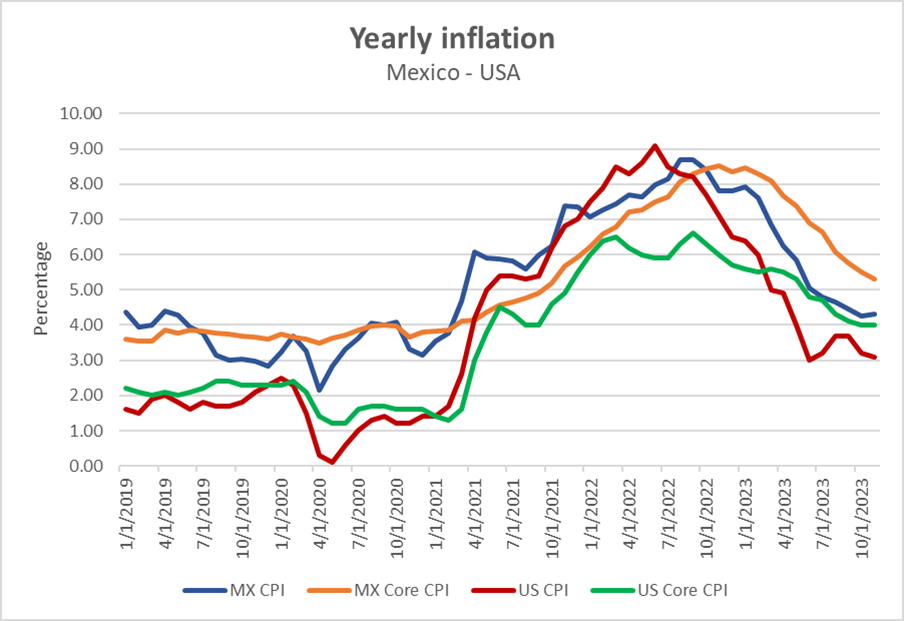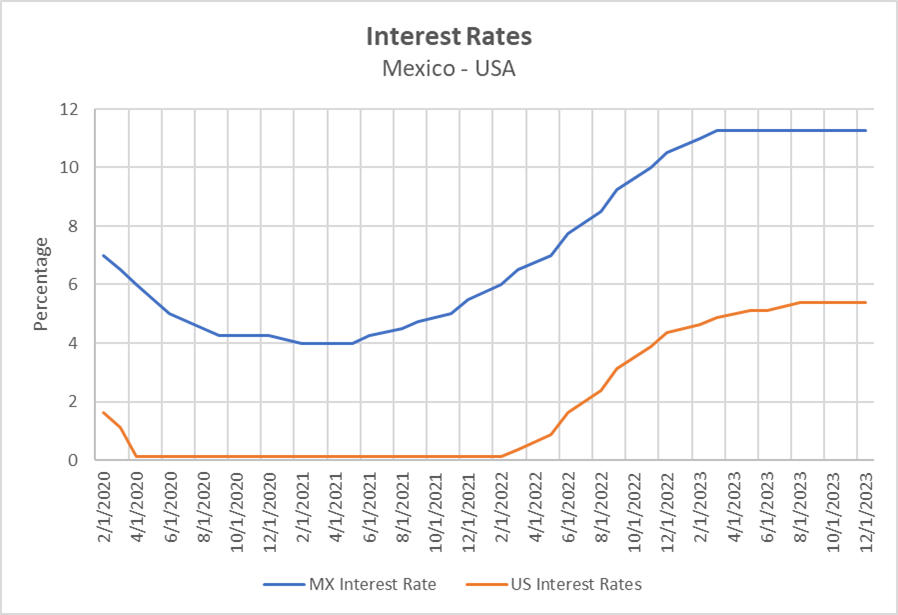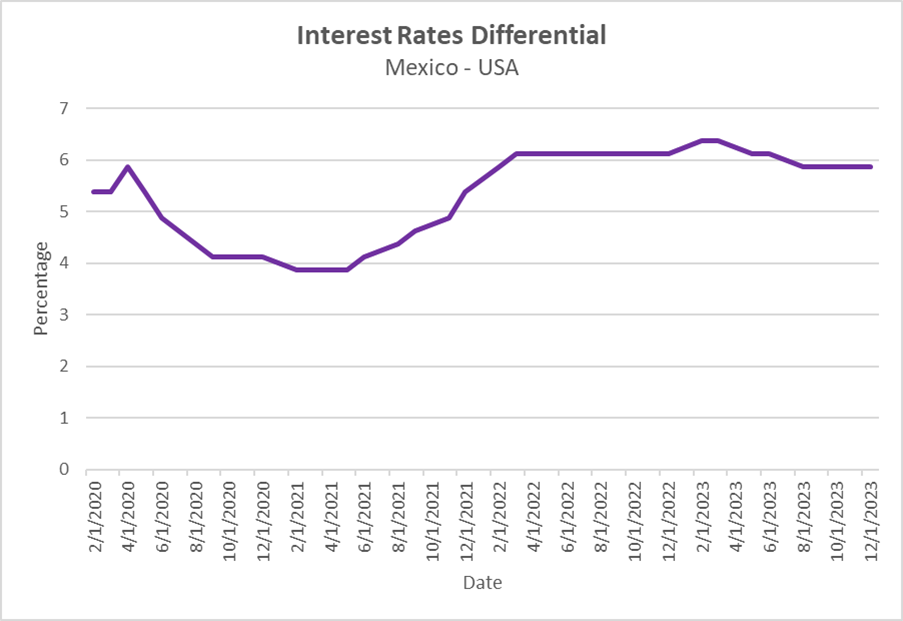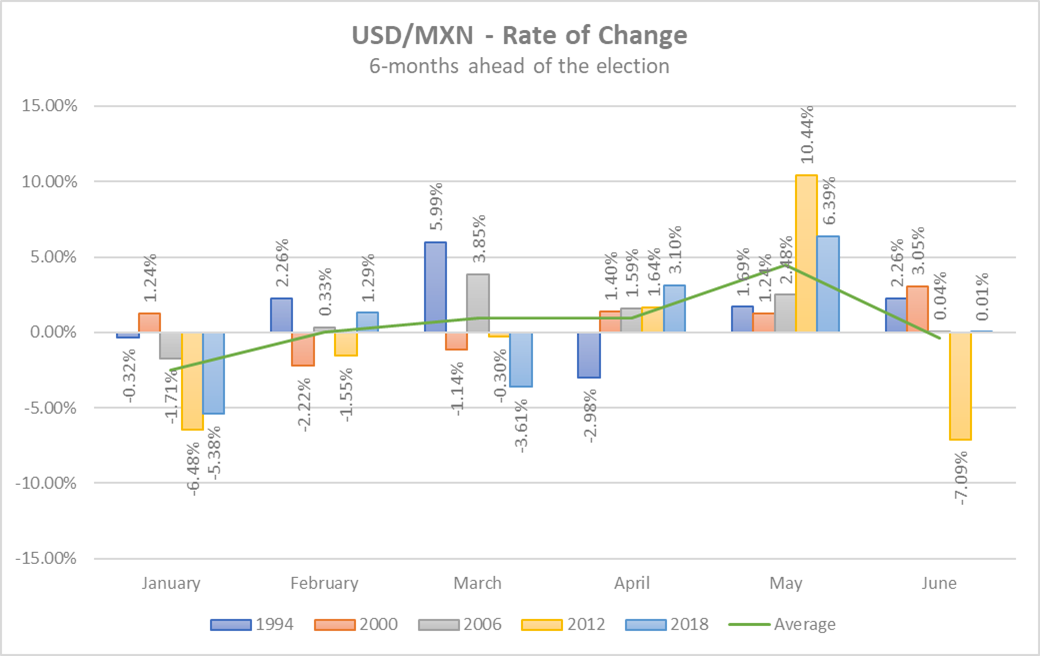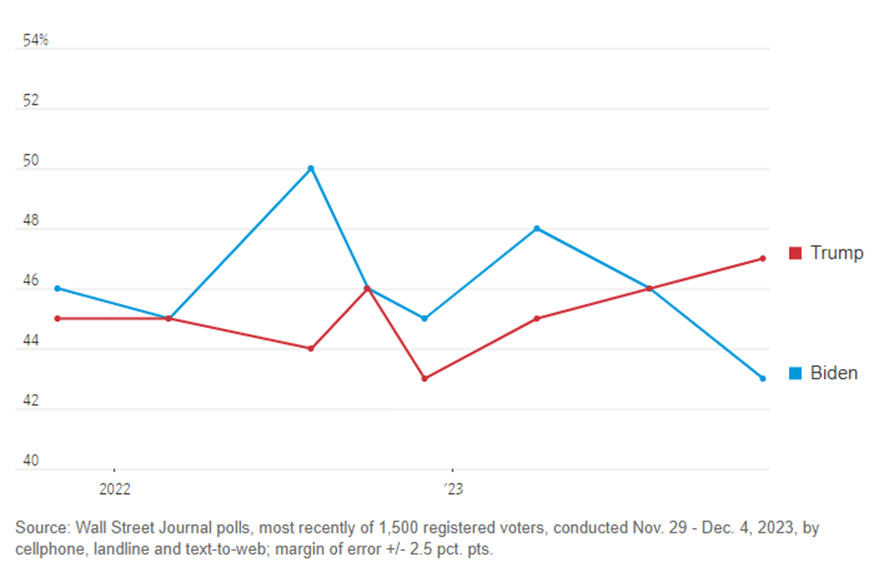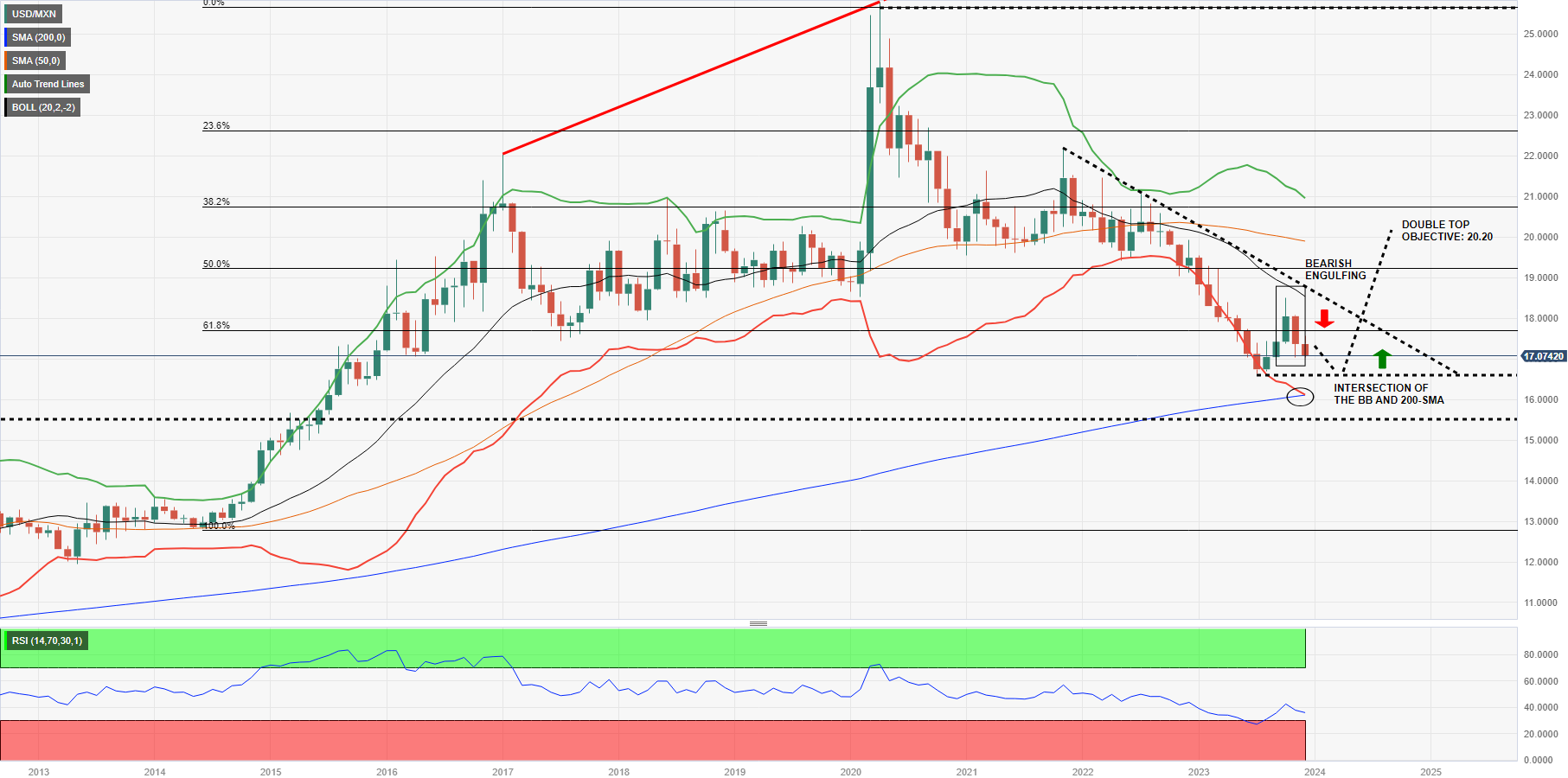- Mexican Peso poised to end 2023 with nearly 12% gain, with USD/MXN hitting an eight-year low at 16.62.
- USD/MXN to remain driven by the difference in interest rates set by Banxico and the Federal Reserve.
- Elections in Mexico and the United States could increase USD/MXN pair volatility.
- USD/MXN Price Analysis: Strong support might keep traders from breaking below 16.00; further recovery seen above 18.49.
The USD/MXN began the year near the highs for 2023, extending the downtrend that started in April 2020 for the third consecutive year. In January, the exotic pair traded sideways before sliding towards its monthly low at around 18.56, but it rallied toward its second-highest level reached during the year at 19.29. By the end of the first quarter, the Mexican Peso (MXN) had weakened, surpassing the 19.00 figure but posted a strong recovery and soared around 12.20% to reach its high of the year at around 16.62. From then on, the USD/MXN pair trimmed some of its gains and is set to register losses of approximately more than 10%, one of its strongest years since 2008.
Mexican Peso drivers in 2023
Factors that weighed on the Mexican Peso were the Silicon Valley Bank (SVB) and the regional bank crisis in the United States (US). The threat of a US government shutdown in May and a Federal Reserve (Fed) rate hike boosted the Greenback (USD). On the Mexican front, the Bank of Mexico (Banxico) reduced its currency hedging program by 50%, and the Mexican Government’s fiscal budget 2024, expected to run its most significant deficit since 1988, was a headwind for the emerging market currency.
On a positive note, the Mexican currency appreciated due to an appetite for risk-perceived currencies, sponsored by a faster-than-expected disinflationary process in Mexico and the US, requiring a less aggressive stance by central banks. In the US, inflation has been trending lower, from 6.4% in January to 3.1% YoY in December, while prices excluding volatile items slid from 5.6% to 4.0% YoY. In Mexico, prices are subsiding, with inflation down from 7.91% to 4.32%, while core figures have dived from 8.45% to 5.30%, both readings annually based.
Inflation comparison - Source: Reuters, FX Street
Consequently, the Fed and Banxico had signaled a pause in their aggressive tightening cycle, keeping the USD/MXN downward pressured toward the year’s end. Nevertheless, growing speculation that the Fed would ease policy by more than 100 basis points, according to the Chicago Board of Trade (CBOT) data, would pressure the Greenback against the Mexican Peso. Additionally, the relocation of American companies from overseas to its southern neighbor, the so-called nearshoring, has increased foreign direct investment in Mexico, keeping the Peso bid.
Interest rate differentials favored the Mexican Peso’s appreciation
Besides that, the 600-basis points interest rate differential favoring Mexico compared to the US kept the “carry trade” intact. The Fed delivered its latest 25 basis points (bps) rate hike in July to the 5.25% - 5.50% range, while Banxico lifted rates by 25 bps to 11.25%.
Interest Rates: Banxico VS. Fed - Source: Reuters, FX Street
2024 Fundamental outlook: What’s ahead for the Mexican Peso?
Inflation and central bank monetary policy to dictate the USD/MXN’s path
Discussions about rate cuts on both sides of the border have gathered traction due to the disinflation process, with both economies on their way to hitting their goals of 3% plus or minus 1% for Banxico and 2% for the Fed. Nevertheless, both central banks aim to achieve their goals by 2025 and 2026.
Regarding the monetary policy path, the Summary of Economic Projections (SEP) released by the Fed suggests that policymakers expect inflation to drop to 2.4%, according to the Core Personal Consumption Expenditures (PCE) price index, the Fed’s preferred gauge for inflation. In addition, Fed officials project the Federal Fund Rates (FFR) to drop to 4.60%, 80 basis points below its current target, suggesting they will cut rates three times, a headwind for the Greenback.
In Mexico, although Banxico’s Governing Council sees upside inflation risks and expects it to hit 3% by the second quarter of 2025, economists estimate the central bank would begin its accommodative cycle in the first half of 2024. Analysts at JP Morgan suggest Banxico would lower rates to 9.75% by the end of 2024, while economists at the Swiss bank UBS see the main reference rate hitting 9.25%, which, according to them, would still be sufficiently restrictive, above the Mexican central bank neutral real rate projected between 1.8% and 3.4%.
It should be said that if Banxico begins its easing cycle before the Fed, that would weigh on the Mexican Peso and open the door for further upside in the USD/MXN pair.
Interest Rates Differential - Source: Reuters, FX Street
Mexico’s political instability and the lack of transparency
Mexican President Andres Manuel Lopez Obrador is expected to present a bill to ditch autonomous bodies like the INAI - Institute for Access to Public Information, used by journalists, civil associations, and citizens to find out how the Government spends its public resources. Besides that, he’s looking to eliminate the Federal Communications Institute (IFT), the Economic Competition Commission (COFECE), and the Energy Regulatory Commission (CRE). These independent bodies regulate and level the playing field between government and private companies.
Those bodies were created to provide transparency and a climate of certainty to local and foreign investors. Nevertheless, their dismissal would hurt nearshoring opportunities and weaken the Mexican currency, generating an environment of uncertainty.
General elections in Mexico
On June 2, 2024, Mexico will host presidential elections and renew the Mexican Congress. In the Presidential race, two women are leading the electoral preferences, according to a November survey made by El Financiero. In first place is Claudia Sheinbaum, the candidate of the country’s ruling leftist party, Morena, along with its allies, Partido Verde (PV) and Partido del Trabajo (PT). She has the support of 50% of voters, trailed by Xochitl Galvez, who represents an alliance of opposition parties named “Frente Amplio por Mexico,” with 31% of the voters, followed by Samuel Garcia with 7% of Movimiento Ciudadano (MC), while people undefined lies at around 12%. However, Garcia´s withdrawal from the presidential race ahead of December 1 could increase the undefined percentage to close to 20% in the following survey.
In the meantime, general elections in Mexico are a driver of the USD/MXN exchange rate. In the last five contests, the USD/MXN has risen 3.50% in the six months before voting day, with the Peso depreciating an average of 4.45% in May, considering elections of 1994, 2000, 2006, 2012, and 2018.
USD/MXN Rate of Change - Source: Reuters, FX Street
Presidential elections in the United States
In 2024, Americans will elect a President and rejuvenate the US Congress. For the Democrats, the candidate would be President Joe Biden, whose approval rate has plummeted from 54% at the start of his presidency to 34%, according to a poll by Monmouth University. On the Republican side, former President Donald Trump leads the party and could also win the election, revealed by a Wall Street Journal poll that sees President Biden lagging Trump by 4%, 43% to 47%, on a hypothetical scenario featuring both candidates.
When Trump was first elected in 2016, the Mexican Peso depreciated 24.79% from January until the week of the election in November, which witnessed the USD/MXN rising from around 17.16 to 21.39 amidst fears surrounding the former President. This means traders should be cautious, as elections in the US could increase USD/MXN volatility the closer we get into the elections.
Expectations for the Mexican economy and the USD/MXN in 2024
During 2023, the Mexican economy has shown strong resilience despite the challenges faced after the COVID-19 crisis, which was sorted without putting pressure on its finances. According to the International Monetary Fund (IMF), the economy is projected to grow 3.2% in 2023, noting the economy was boosted by “private consumption and investment, with notable strength in service sectors, construction, and auto production. This has led to record-low unemployment rates and record-high manufacturing capacity utilization rates.”
However, challenges for the next year emerge; even though Mexico’s economy is expected to grow, it will do it at a slower pace than in 2023. The Gross Domestic Product (GDP) is projected at 2.1%, down from 3.2% amid expectations of lower growth in the US, the country’s largest trading partner. There is a slim chance of a recession in the US, which the USD/MXN would likely undermine. However, a deeper-than-estimated slowdown could trigger a shift in market sentiment, spurring outflows from risk-perceived currencies like the Mexican Peso.
If the USD/MXN exchange rate finishes the year at around 17.00, here’s a projection based on the latest five elections in Mexico:
USD/MXN Projections - Source: Reuters, FX Street
2024 Technical outlook: USD/MXN set for further downside
The monthly chart portrays the USD/MXN pair with a downward bias in the near term. The signals that generated the downtrend, which commenced around the last couple of months of 2021, were a bearish engulfing candle pattern and Relative Strength Index (RSI) piercing below the 50-midline. The pair’s drop that has lasted throughout 2022 and 2023 is being reinforced by the death cross between the 20 and 50-SMAs.
The USD/MXN pair, after briefly falling below the 61.8% Fibonacci Retracement level at 17.69 and hitting a year-to-date low of 16.62, reversed and reclaimed this level. However, a 'bearish engulfing' candle pattern around the 61.8% level led to a decline below 17.10, threatening the 17.00 mark. A further drop could see sellers targeting the 2023 low of 16.62.
In that outcome, if USD/MXN sellers stepped in, they could drag prices toward the 16.00 figure, followed by the March 2009 high at 15.56. For that to happen, the Relative Strength Index (RSI) must remain on a downward slope, while US Dollar bears would face a strong support level in the confluence of the bottom of the Bollinger band and the 200-Simple Moving Average (SMA) at around 16.10/11.
On the other hand, buyers stepping in at around last year’s low of 16.62, could lift the USD/MXN exchange rates above the 17.00 figure. The next resistance level would be the 18.00 figure, which, once surpassed, would put into play the October 2023 high of 18.49, which will validate a ´double bottom´ chart pattern. In that event, the measured target would be 20.20, slightly above the 50-SMA at 19.89.
Mexican Peso FAQs
What key factors drive the Mexican Peso?
The Mexican Peso (MXN) is the most traded currency among its Latin American peers. Its value is broadly determined by the performance of the Mexican economy, the country’s central bank’s policy, the amount of foreign investment in the country and even the levels of remittances sent by Mexicans who live abroad, particularly in the United States. Geopolitical trends can also move MXN: for example, the process of nearshoring – or the decision by some firms to relocate manufacturing capacity and supply chains closer to their home countries – is also seen as a catalyst for the Mexican currency as the country is considered a key manufacturing hub in the American continent. Another catalyst for MXN is Oil prices as Mexico is a key exporter of the commodity.
How do decisions of the Banxico impact the Mexican Peso?
The main objective of Mexico’s central bank, also known as Banxico, is to maintain inflation at low and stable levels (at or close to its target of 3%, the midpoint in a tolerance band of between 2% and 4%). To this end, the bank sets an appropriate level of interest rates. When inflation is too high, Banxico will attempt to tame it by raising interest rates, making it more expensive for households and businesses to borrow money, thus cooling demand and the overall economy. Higher interest rates are generally positive for the Mexican Peso (MXN) as they lead to higher yields, making the country a more attractive place for investors. On the contrary, lower interest rates tend to weaken MXN.
How does economic data influence the value of the Mexican Peso?
Macroeconomic data releases are key to assess the state of the economy and can have an impact on the Mexican Peso (MXN) valuation. A strong Mexican economy, based on high economic growth, low unemployment and high confidence is good for MXN. Not only does it attract more foreign investment but it may encourage the Bank of Mexico (Banxico) to increase interest rates, particularly if this strength comes together with elevated inflation. However, if economic data is weak, MXN is likely to depreciate.
How does broader risk sentiment impact the Mexican Peso?
As an emerging-market currency, the Mexican Peso (MXN) tends to strive during risk-on periods, or when investors perceive that broader market risks are low and thus are eager to engage with investments that carry a higher risk. Conversely, MXN tends to weaken at times of market turbulence or economic uncertainty as investors tend to sell higher-risk assets and flee to the more-stable safe havens.
Information on these pages contains forward-looking statements that involve risks and uncertainties. Markets and instruments profiled on this page are for informational purposes only and should not in any way come across as a recommendation to buy or sell in these assets. You should do your own thorough research before making any investment decisions. FXStreet does not in any way guarantee that this information is free from mistakes, errors, or material misstatements. It also does not guarantee that this information is of a timely nature. Investing in Open Markets involves a great deal of risk, including the loss of all or a portion of your investment, as well as emotional distress. All risks, losses and costs associated with investing, including total loss of principal, are your responsibility. The views and opinions expressed in this article are those of the authors and do not necessarily reflect the official policy or position of FXStreet nor its advertisers. The author will not be held responsible for information that is found at the end of links posted on this page.
If not otherwise explicitly mentioned in the body of the article, at the time of writing, the author has no position in any stock mentioned in this article and no business relationship with any company mentioned. The author has not received compensation for writing this article, other than from FXStreet.
FXStreet and the author do not provide personalized recommendations. The author makes no representations as to the accuracy, completeness, or suitability of this information. FXStreet and the author will not be liable for any errors, omissions or any losses, injuries or damages arising from this information and its display or use. Errors and omissions excepted.
The author and FXStreet are not registered investment advisors and nothing in this article is intended to be investment advice.
Recommended Content
Editors’ Picks

EUR/USD bounces off lows, retests 1.1370
Following an early drop to the vicinity of 1.1310, EUR/USD now manages to regain pace and retargets the 1.1370-1.1380 band on the back of a tepid knee-jerk in the US Dollar, always amid growing optimism over a potential de-escalation in the US-China trade war.

GBP/USD trades slightly on the defensive in the low-1.3300s
GBP/USD remains under a mild selling pressure just above 1.3300 on Friday, despite firmer-than-expected UK Retail Sales. The pair is weighed down by a renewed buying interest in the Greenback, bolstered by fresh headlines suggesting a softening in the rhetoric surrounding the US-China trade conflict.

Gold remains offered below $3,300
Gold reversed Thursday’s rebound and slipped toward the $3,260 area per troy ounce at the end of the week in response to further improvement in the market sentiment, which was in turn underpinned by hopes of positive developments around the US-China trade crisis.

Ethereum: Accumulation addresses grab 1.11 million ETH as bullish momentum rises
Ethereum saw a 1% decline on Friday as sellers dominated exchange activity in the past 24 hours. Despite the recent selling, increased inflows into accumulation addresses and declining net taker volume show a gradual return of bullish momentum.

Week ahead: US GDP, inflation and jobs in focus amid tariff mess – BoJ meets
Barrage of US data to shed light on US economy as tariff war heats up. GDP, PCE inflation and nonfarm payrolls reports to headline the week. Bank of Japan to hold rates but may downgrade growth outlook. Eurozone and Australian CPI also on the agenda, Canadians go to the polls.

The Best brokers to trade EUR/USD
SPONSORED Discover the top brokers for trading EUR/USD in 2025. Our list features brokers with competitive spreads, fast execution, and powerful platforms. Whether you're a beginner or an expert, find the right partner to navigate the dynamic Forex market.
